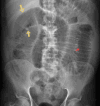Atypical Presentation of Small Bowel Neuroendocrine Carcinoma Leading to Acute Obstruction
- PMID: 40546570
- PMCID: PMC12182643
- DOI: 10.7759/cureus.84661
Atypical Presentation of Small Bowel Neuroendocrine Carcinoma Leading to Acute Obstruction
Abstract
Rare neoplasms called neuroendocrine tumors (NETs) develop from intestinal enterochromaffin cells. They commonly produce symptoms through the secretion of serotonin along with other vasoactive peptides, resulting in carcinoid syndrome, characterized by cutaneous flushing and diarrhea. NETs are a very aggressive type of cancer, for which prognostic factors are lacking. They are also rarely found in males and young adults. Carcinoid tumors make up an atypical and intricate disease spectrum with various clinical features. The combination of etoposide and carboplatin can enhance overall survival in complex WHO stage 3 neuroendocrine carcinoma with regional lymph node involvement and a generally poor prognosis. However, in the absence of distant metastasis and with a relatively fair performance index, this treatment may be more effective. In this instance, we report a neuroendocrine tumor case that presented unusually as an acute intestinal obstruction. The patient had resection and anastomosis of the small bowel of the affected region along with the surrounding mesentery.
Keywords: acute intestinal obstruction; carcinoid syndrome; gasterointesinal tract; neuro endocrine tumor; neuroendocrine carcinoma(nec).
Copyright © 2025, Kumar et al.
Conflict of interest statement
Human subjects: Consent for treatment and open access publication was obtained or waived by all participants in this study. Conflicts of interest: In compliance with the ICMJE uniform disclosure form, all authors declare the following: Payment/services info: All authors have declared that no financial support was received from any organization for the submitted work. Financial relationships: All authors have declared that they have no financial relationships at present or within the previous three years with any organizations that might have an interest in the submitted work. Other relationships: All authors have declared that there are no other relationships or activities that could appear to have influenced the submitted work.
Figures




References
-
- A 5-decade analysis of 13,715 carcinoid tumors. Modlin IM, Lye KD, Kidd M. Cancer. 2003;97:934–959. - PubMed
-
- Gastroenteropancreatic neuroendocrine tumours (GEP-NET) - imaging and staging. Baumann T, Rottenburger C, Nicolas G, Wild D. https://doi.org/10.1016/j.beem.2016.01.003. Best Pract Res Clin Endocrinol Metab. 2016;30:45–57. - PubMed
-
- Prognostic factors of long-term outcome in gastroenteropancreatic neuroendocrine tumours. Pape UF, Berndt U, Müller-Nordhorn J, et al. https://doi.org/10.1677/ERC-08-0017. Endocr Relat Cancer. 2008;15:1083–1097. - PubMed
-
- Prognostic factors in neuroendocrine carcinoma: biological markers are more useful than histomorphological markers. Freis P, Graillot E, Rousset P, Hervieu V, Chardon L, Lombard-Bohas C, Walter T. https://doi.org/10.1038/srep40609. Sci Rep. 2017;7:40609. - PMC - PubMed
-
- Therapeutic options for neuroendocrine tumors: a systematic review and network meta-analysis. Kaderli RM, Spanjol M, Kollár A, et al. https://doi.org/10.1001/jamaoncol.2018.6720. JAMA Oncol. 2019;5:480–489. - PMC - PubMed
Publication types
LinkOut - more resources
Full Text Sources
